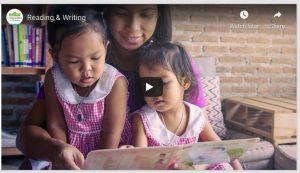KEEP YOUR CHILD’S DEVELOPMENT ON PACE DURING THE PANDEMIC
Benefits of Reading with Your Child
While they use different terms, Guilford Basics (Read and Discuss Stories) and Read Charlotte (Active Reading), both offer great tips for engaging your child while reading. Below are a few suggestions from them:
Commit to Read Every Day Try to set aside 15 minutes every day to read with your child. Younger children may not understand for a while, but focus on the pictures, pointing to them and explaining colors, shapes, and what the characters are doing. What is important is that they hear your words, see the pictures and start to develop positive feelings about books. You can read the same book more than once, highlighting different things and asking different questions.
Keep It Simple Try to choose books that are sturdy, short and have simple, colorful pictures.
Snuggle Up Hold your young child in your lap as you read so they can see the pictures and feel cozy.
Speak with Expression Use an exaggerated voice and facial expressions to make it more interesting! Use a different voice for each character.
Actively Involve Them As your baby develops coordination, involve them more in the reading experience. Let them hold the book or turn the pages.
Follow Their Lead Let your child guide the reading experience. When they start to lose interest, try another book or stop. Not being forced to keep going will keep them excited about reading!
Name That Name and talk about the parts of the pictures that interest your child or that they point at.
Warm Up Before you open the book, check out the cover. Read the title. Look at the picture. Ask your child what they think the book might be about.
Help Them Follow Along Point to the words and pictures. This helps your child understand how reading works. For example, we read from left to right on the page.
Don’t Be Too Serious Make it fun! Your child may want to turn the page before you’ve finished it. If they can’t sit still for the whole book, that’s okay.
Act It Out Your child might be inspired to play based on the stories you read. Can they follow the characters’ actions? What toys or objects might be props?
Help Them Build Vocabulary Practice saying new words with your child as you read. Point to pictures that relate to the new word. Create a “kid-friendly” definition for the word and ask questions about the word.
Ask Questions Ask both basic and open-ended questions. Basic questions are things about the story that won’t change over time. “What is the boy’s name?” “What color are the dog’s spots?” Open-ended questions allow the child to use imagination and apply knowledge. “What do you think will happen next?” or “Why is the girl happy?” Respond to your child’s comments and questions. Show interest in their ideas.
Make Connections Help your child make personal connections to the stories you read. For example, “Do you remember when we saw the fire truck? How did it sound?”
These tips will help you make reading fun for your child and start them on a path to lifelong reading and learning.
For a complete list of tips provided by each organization, visit their websites by clicking on the links below:
Guilford Basics Read and Discuss Stories


